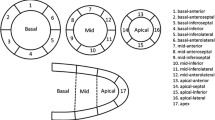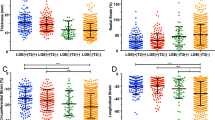Abstract
Diffusion-weighted imaging (DWI) has been confirmed to be associated with late gadolinium enhancement (LGE) in hypertrophic cardiomyopathy (HCM). In this context, we aimed to study whether DWI could reflect the active tissue injury and edema information of HCM which were usually indicated by T2 weighted images. Forty HCM patients were examined using a 3.0 T magnetic resonance scanner. Cine, T2-weighted short tau inversion recovery (T2-STIR), DWI and LGE sequences were acquired. T1 mapping was also included to quantify the focal and diffuse fibrosis. Cardiac troponin I (cTnI) was tested to assess the recently myocardial injury. Student’s t-test, Mann–Whitney U test, One-way analysis, Kruskal–Wallis analysis, the Spearman correlation analysis, and multivariable regression were used in this study. The apparent diffusion coefficient (ADC) was significantly elevated in the cTnI positive group (P = 0.01) and correlated with LGE (ρ = 0.312, P = 0.049) and HighT2 extent (ρ = 0.443, P = 0.004) in the global level. In the segmental analysis, the ADC significantly differentiated the segments with and without HighT2/LGE presence (P = 0.00). The average ADC values were higher in segments with HighT2 and LGE coexistence than in those with only LGE presence (P < 0.05). Multivariable regression indicated that segmental HighT2 and LGE were both contributing factors to the ADC values. In this study of HCM, we confirmed that ADC as a molecular diffusion parameter reflects the replacement fibrosis of myocardium. Moreover, it also reveals edema extent and its association with serum cTnI.






Similar content being viewed by others
References
Oh D, Ridgway JP, Kuehne T, Berger F, Plein S, Sivananthan M, Messroghli DR (2012) Cardiovascular magnetic resonance of myocardial edema using a short inversion time inversion recovery (STIR) black-blood technique: diagnostic accuracy of visual and semi-quantitative assessment. J Cardiovasc Magn Reson 14:22
Butler TL, Egan JR, Graf FG, Au CG, McMahon AC, North KN, Winlaw DS (2009) Dysfunction induced by ischemia versus edema: does edema matter? J Thorac Cardiovasc Surg 138(1):141–147
Bragadeesh T, Jayaweera AR, Pascotto M, Micari A, Le DE, Kramer CM, Epstein FH, Kaul S (2008) Post-ischaemic myocardial dysfunction (stunning) results from myofibrillar oedema. Heart 94(2):166–171
Garcia-Dorado D, Theroux P, Munoz R, Alonso J, Elizaga J, Fernandez-Aviles F, Botas J, Solares J, Soriano J, Duran JM (1992) Favorable effects of hyperosmotic reperfusion on myocardial edema and infarct size. Am J Physiol 262(1 Pt 2):H17–H22
Davis KL, Laine GA, Geissler HJ, Mehlhorn U, Brennan M, Allen SJ (2000) Effects of myocardial edema on the development of myocardial interstitial fibrosis. Microcirculation 7(4):269–280
Higgins CB, Herfkens R, Lipton MJ, Sievers R, Sheldon P, Kaufman L, Crooks LE (1983) Nuclear magnetic resonance imaging of acute myocardial infarction in dogs: alterations in magnetic relaxation times. Am J Cardiol 52(1):184–188
Abdel-Aty H, Cocker M, Strohm O, Filipchuk N, Friedrich MG (2008) Abnormalities in T2-weighted cardiovascular magnetic resonance images of hypertrophic cardiomyopathy: regional distribution and relation to late gadolinium enhancement and severity of hypertrophy. J Magn Reson Imaging 28(1):242–245
Melacini P, Corbetti F, Calore C, Pescatore V, Smaniotto G, Pavei A, Bobbo F, Cacciavillani L, Iliceto S (2008) Cardiovascular magnetic resonance signs of ischemia in hypertrophic cardiomyopathy. Int J Cardiol 128(3):364–373
Gommans DF, Cramer GE, Bakker J, Michels M, Dieker HJ, Timmermans J, Fouraux MA, Marcelis CL, Verheugt FW, Brouwer MA et al (2017) High T2-weighted signal intensity is associated with elevated troponin T in hypertrophic cardiomyopathy. Heart 103(4):293–299
Todiere G, Pisciella L, Barison A, Del Franco A, Zachara E, Piaggi P, Re F, Pingitore A, Emdin M, Lombardi M et al (2014) Abnormal T2-STIR magnetic resonance in hypertrophic cardiomyopathy: a marker of advanced disease and electrical myocardial instability. PLoS ONE 9(10):e111366
Hen Y, Iguchi N, Machida H, Takada K, Utanohara Y, Sumiyoshi T (2013) High signal intensity on T2-weighted cardiac magnetic resonance imaging correlates with the ventricular tachyarrhythmia in hypertrophic cardiomyopathy. Heart Vessels 28(6):742–749
Hen Y, Takara A, Iguchi N, Utanohara Y, Teraoka K, Takada K, Machida H, Takamisawa I, Takayama M, Yoshikawa T (2018) High signal intensity on T2-weighted cardiovascular magnetic resonance imaging predicts life-threatening arrhythmic events in hypertrophic cardiomyopathy patients. Circ J 82(4):1062–1069
Gommans DHF, Cramer GE, Bakker J, Dieker HJ, Michels M, Fouraux MA, Marcelis CLM, Verheugt FWA, Timmermans J, Brouwer MA et al (2018) High T2-weighted signal intensity for risk prediction of sudden cardiac death in hypertrophic cardiomyopathy. Int J Cardiovasc Imaging 34(1):113–120
Schelbert EB, Moon JC (2015) exploiting differences in myocardial compartments with native T1 and extracellular volume fraction for the diagnosis of hypertrophic cardiomyopathy. Circ Cardiovasc Imaging. https://doi.org/10.1161/CIRCIMAGING.115.004232
Friedrich MG (2017) Why edema is a matter of the heart. Circ Cardiovasc Imaging. https://doi.org/10.1161/CIRCIMAGING.117.006062
Puntmann VO, Peker E, Chandrashekhar Y, Nagel E (2016) T1 mapping in characterizing myocardial disease: a comprehensive review. Circ Res 119(2):277–299
Amano Y, Yanagisawa F, Tachi M, Hashimoto H, Imai S, Kumita S (2017) Myocardial T2 mapping in patients with hypertrophic cardiomyopathy. J Comput Assist Tomogr 41(3):344–348
Edelman RR, Gaa J, Wedeen VJ, Loh E, Hare JM, Prasad P, Li W (1994) In vivo measurement of water diffusion in the human heart. Magn Reson Med 32(3):423–428
Nguyen C, Fan Z, Sharif B, He Y, Dharmakumar R, Berman DS, Li D (2014) In vivo three-dimensional high resolution cardiac diffusion-weighted MRI: a motion compensated diffusion-prepared balanced steady-state free precession approach. Magn Reson Med 72(5):1257–1267
Bueno-Orovio A, Teh I, Schneider JE, Burrage K, Grau V (2016) Anomalous diffusion in cardiac tissue as an index of myocardial microstructure. IEEE Trans Med Imaging 35(9):2200–2207
Edalati M, Lee GR, Hui W, Taylor MD, Li YY (2016) Single-shot turbo spin echo acquisition for in vivo cardiac diffusion MRI. Conf Proc IEEE Eng Med Biol Soc 2016:5529–5532
McClymont D, Teh I, Carruth E, Omens J, McCulloch A, Whittington HJ, Kohl P, Grau V, Schneider JE (2017) Evaluation of non-Gaussian diffusion in cardiac MRI. Magn Reson Med 78(3):1174–1186
An DA, Chen BH, Rui W, Shi RY, Bu J, Ge H, Hu J, Xu JR, Wu LM (2018) Diagnostic performance of intravoxel incoherent motion diffusion-weighted imaging in the assessment of the dynamic status of myocardial perfusion. J Magn Reson Imaging 48:1602–1609
Nguyen C, Fan Z, Xie Y, Dawkins J, Tseliou E, Bi X, Sharif B, Dharmakumar R, Marban E, Li D (2014) In vivo contrast free chronic myocardial infarction characterization using diffusion-weighted cardiovascular magnetic resonance. J Cardiovasc Magn Reson Off J Soc Cardiovasc Magn Reson 16:68
Laissy JP, Gaxotte V, Ironde-Laissy E, Klein I, Ribet A, Bendriss A, Chillon S, Schouman-Claeys E, Steg PG, Serfaty JM (2013) Cardiac diffusion-weighted MR imaging in recent, subacute, and chronic myocardial infarction: a pilot study. J Magn Reson Imaging 38(6):1377–1387
Nguyen C, Lu M, Fan Z, Bi X, Kellman P, Zhao S, Li D (2015) Contrast-free detection of myocardial fibrosis in hypertrophic cardiomyopathy patients with diffusion-weighted cardiovascular magnetic resonance. J Cardiovasc Magn Reson Off J Soc Cardiovasc Magn Reson 17:107
Wu R, An DA, Hu J, Jiang M, Guo Q, Xu JR, Wu LM (2018) The apparent diffusion coefficient is strongly correlated with extracellular volume, a measure of myocardial fibrosis, and subclinical cardiomyopathy in patients with systemic lupus erythematosus. Acta Radiol 59(3):287–295
Witschey WR, Zsido GA, Koomalsingh K, Kondo N, Minakawa M, Shuto T, McGarvey JR, Levack MM, Contijoch F, Pilla JJ et al (2012) In vivo chronic myocardial infarction characterization by spin locked cardiovascular magnetic resonance. J Cardiovasc Magn Reson Off J Soc Cardiovasc Magn Reson 14:37
Nakajo Y, Zhao Q, Enmi JI, Iida H, Takahashi JC, Kataoka H, Yamato K, Yanamoto H (2018) Early detection of cerebral infarction after focal ischemia using a new MRI indicator. Mol Neurobiol 56:658–670
Battey TW, Karki M, Singhal AB, Wu O, Sadaghiani S, Campbell BC, Davis SM, Donnan GA, Sheth KN, Kimberly WT (2014) Brain edema predicts outcome after nonlacunar ischemic stroke. Stroke 45(12):3643–3648
Potet J, Rahmouni A, Mayer J, Vignaud A, Lim P, Luciani A, Dubois-Rande JL, Kobeiter H, Deux JF (2013) Detection of myocardial edema with low-b-value diffusion-weighted echo-planar imaging sequence in patients with acute myocarditis. Radiology 269(2):362–369
Okayama S, Uemura S, Saito Y (2009) Detection of infarct-related myocardial edema using cardiac diffusion-weighted magnetic resonance imaging. Int J Cardiol 133(1):e20–21
Kociemba A, Pyda M, Katulska K, Lanocha M, Siniawski A, Janus M, Grajek S (2013) Comparison of diffusion-weighted with T2-weighted imaging for detection of edema in acute myocardial infarction. J Cardiovasc Magn Reson Off J Soc Cardiovasc Magn Reson 15:90
Kubo T, Kitaoka H, Okawa M, Yamanaka S, Hirota T, Hoshikawa E, Hayato K, Yamasaki N, Matsumura Y, Yasuda N et al (2010) Serum cardiac troponin I is related to increased left ventricular wall thickness, left ventricular dysfunction, and male gender in hypertrophic cardiomyopathy. Clin Cardiol 33(2):E1–E7
Agarwal A, Yousefzai R, Shetabi K, Samad F, Aggarwal S, Cho C, Bush M, Jan MF, Khandheria BK, Paterick TE et al (2017) Relationship of cardiac troponin to systolic global longitudinal strain in hypertrophic cardiomyopathy. Echocardiography 34(10):1470–1477
Okamoto R, Hirashiki A, Cheng XW, Yamada T, Shimazu S, Shinoda N, Okumura T, Takeshita K, Bando Y, Kondo T et al (2013) Usefulness of serum cardiac troponins T and I to predict cardiac molecular changes and cardiac damage in patients with hypertrophic cardiomyopathy. Int Heart J 54(4):202–206
Hamlin SA, Henry TS, Little BP, Lerakis S, Stillman AE (2014) Mapping the future of cardiac MR imaging: case-based review of T1 and T2 mapping techniques. Radiographics 34(6):1594–1611
Le Bihan D, van Zijl P (2002) From the diffusion coefficient to the diffusion tensor. NMR Biomed 15(7–8):431–434
Friedrich MG, Sechtem U, Schulz-Menger J, Holmvang G, Alakija P, Cooper LT, White JA, Abdel-Aty H, Gutberlet M, Prasad S et al (2009) Cardiovascular magnetic resonance in myocarditis: a JACC White Paper. J Am Coll Cardiol 53(17):1475–1487
Cramer G, Bakker J, Gommans F, Brouwer M, Kurvers M, Fouraux M, Verheugt F, Kofflard M (2014) Relation of highly sensitive cardiac troponin T in hypertrophic cardiomyopathy to left ventricular mass and cardiovascular risk. Am J Cardiol 113(7):1240–1245
Maron BJ, Wolfson JK, Epstein SE, Roberts WC (1986) Intramural (“small vessel”) coronary artery disease in hypertrophic cardiomyopathy. J Am Coll Cardiol 8(3):545–557
Pop M, Ghugre NR, Ramanan V, Morikawa L, Stanisz G, Dick AJ, Wright GA (2013) Quantification of fibrosis in infarcted swine hearts by ex vivo late gadolinium-enhancement and diffusion-weighted MRI methods. Phys Med Biol 58(15):5009–5028
Abdel-Aty H, Zagrosek A, Schulz-Menger J, Taylor AJ, Messroghli D, Kumar A, Gross M, Dietz R, Friedrich MG (2004) Delayed enhancement and T2-weighted cardiovascular magnetic resonance imaging differentiate acute from chronic myocardial infarction. Circulation 109(20):2411–2416
Hinojar R, Foote L, Arroyo Ucar E, Jackson T, Jabbour A, Yu CY, McCrohon J, Higgins DM, Carr-White G, Mayr M et al (2015) Native T1 in discrimination of acute and convalescent stages in patients with clinical diagnosis of myocarditis: a proposed diagnostic algorithm using CMR. JACC Cardiovasc Imaging 8(1):37–46
Acknowledgements
Ruo-yang Shi and Dong-aolei An contributed equally to this work.
Funding
National Natural Science Foundation of China (Grant Nos.81873886 and 81873887), Shanghai Municipal Commission of Health and Family Planning excellent young talent program (Grant No. 2017YQ031), Shanghai Jiao Tong University medical cross project (Grant No. YG2017QN44), Shanghai Shenkang Hospital Development Center Clinical Research and Cultivation Project (Grant No. SHDC12018X21), Shanghai Science and technology innovation action plan, technology standard project Grant numbers: (Grant No. 19DZ2203800).
Author information
Authors and Affiliations
Corresponding authors
Ethics declarations
Conflict of interest
The authors of this manuscript declare no relationships with any companies, whose products or services may be related to the subject matter of the article.
Additional information
Publisher's Note
Springer Nature remains neutral with regard to jurisdictional claims in published maps and institutional affiliations.
Electronic supplementary material
Below is the link to the electronic supplementary material.
Rights and permissions
About this article
Cite this article
Shi, Ry., An, Da., Chen, Bh. et al. Diffusion-weighted imaging in hypertrophic cardiomyopathy: association with high T2-weighted signal intensity in addition to late gadolinium enhancement. Int J Cardiovasc Imaging 36, 2229–2238 (2020). https://doi.org/10.1007/s10554-020-01933-2
Received:
Accepted:
Published:
Issue Date:
DOI: https://doi.org/10.1007/s10554-020-01933-2




